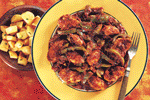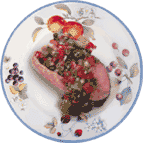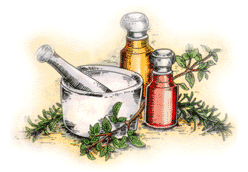|
- Garlic
- "Lehsan" in Urdu -
is a member of the lily family (Allium sativum); the highly aromatic and strongly flavored edible bulb (called a head) is covered in a papery layer and is composed of several sections (called cloves), each of which is also covered with a papery membrane; used as a distinctive flavoring in cuisines.
- Garlic Paste
- "Pisa Lehsan" in Urdu -
is a paste made from fresh Garlic. It has an even finer texture than minced garlic. This is an essential ingredient for Pakistani dishes and is usually paired up with Ginger and often sold as a mixed form of both ingredients.
- Garnish
- "Baghaar" in Urdu -
is a substance used as an embellishment or decoration on a prepared food dish or drink item. In some cases, it may give added or contrasting flavor, but a typical garnish is used to augment the visual impact of the plate, not just enhance the flavor.
- Gherkins
- "Tindora" in Urdu -
is a fruit similar in form and nutritional value to a cucumber.
- Gingelly
- "Til" in Urdu -
also called "Sesame", is an East Indian annual erect herb; source of sesame seed or benniseed and sesame oil.
- Gingelly Oil
- "Til Ka Tail" in Urdu -
also called "Sesame Oil", is an edible vegetable oil derived from sesame seeds. Besides being used as a cooking oil in Pakistan and South India, it is often used as a flavor enhancer in Chinese, Korean, and to a lesser extent Southeast Asian cuisine.
- Ginger
- "Adrak" in Urdu -
is a tuber that is consumed whole as a delicacy, medicine, or spice. It is commonly used whole or as a paste form in typically every Pakistani dish, along with Garlic.
- Ginger Paste
- "Pisa Lehsan" in Urdu -
is a paste made from fresh Ginger. It is a pungent, aromatic paste that can be used as a marinade for meat, poultry and seafood or added to sauces. This is an essential ingredient for Pakistani dishes and is usually paired up with Ginger and often sold as a mixed form of both ingredients.
- Goat
- "Bakra" in Urdu -
is the flesh or meat of a domesticated animal closely related to the sheep.
- Gooseberry
- "Amla" in Urdu -
is a fruit closely related to the currant; Any of several other unrelated fruits, such as the Chinese gooseberry (kiwifruit) and the Indian gooseberry (amla); an additional person that is neither necessary nor wanted in a given situation.
- Gram Flour
- "Besan" in Urdu -
A flour made from ground chickpeas, a legume otherwise known as chana dal. It is also known as chickpea flour, garbanzo flour, or besan . Used in many countries, it is a staple ingredient in Indian, Pakistani and Bangladeshi cuisines, and in the form of a paste with water or yoghurt, a popular facial exfoliant in the Indian Subcontinent. Moreover, when mixed with an equal proportion of water, can be used as an egg-replacer in vegan cooking.
- Gram Lentils
- "Dal" in Urdu -
comes in many types of Gram Lentils. Some are: Yellow Gram, Black Gram, and Split Gram. Yellow Gram is a common type cooked which is Chana Dal.
- Granulated Sugar
- "Shakkar" or "Cheeni" in Urdu -
is an informal term for a class of edible crystalline substances, mainly sucrose, lactose, and fructose characterized by a sweet flavor. In food, sugar almost exclusively refers to sucrose, which primarily comes from sugar cane and sugar beet.
- Grapes
- "Angoor" in Urdu -
is the non-climacteric fruit, botanically a true berry, that grows on the perennial and deciduous woody vines of the genus Vitis. Grapes can be eaten raw or used for making jam, juice, jelly, vinegar, drugs, wine, grape seed extracts, raisins, and grape seed oil.
- Gravy
- "Saalan" in Urdu -
is a sauce made often from the juices that run naturally from meat or vegetables during cooking.
- Green Beans
- "Phali" in Urdu -
is a long, slender green pod that contains several small seeds; the entire crisp pod is edible; also known as a string bean (because of the fibrous string that runs down the side; modern varieties do not have this fiber), fresh bean and snap bean.
- Green Berry
- "Bair" or "Ber" in Urdu -
also known as "Indian Jujube", is a tropical fruit that grows on a Ber Tree. It usually varies in shape, colour
and size and may be round, oval or oblong in shape or yellow, green, reddish or purple/dark brown in colour.
- Green Chili
- "Hari Mirch" in Urdu -
are commonly used in Pakistani and Indian dishes. They are also eaten fresh and whole with meals. Some dishes in North India, especially Punjab are served with fresh whole green chilis, along with lime or tomato slices.
- Green Gram
- "Moong" in Urdu -
is erect bushy annual widely cultivated in warm regions of India and Indonesia and United States for forage and especially its edible seeds; chief source of bean sprouts used in Chinese cookery.
- Green Onion
- "Hari Pyaz" in Urdu -
also known as, scallion, spring onion, or salad onion in many countries, is an edible plant. The upper green portion is hollow. It lacks a fully developed root bulb. Harvested for their taste, they are milder than most onions.
- Green Peas
- "Mattar" in Urdu -
is most commonly the small spherical seed or the seed-pod of the legume Pisum sativum. Each pod contains several peas. Although it is botanically a fruit, it is treated as a vegetable in cooking.
- Green Pumpkin
- "Kashi Phal" or "Kaddu" in Urdu -
is a gourd-like squash commonly cooked as a Kaddu Bhaji with Pakistani Spices.
- Groundnut
- "Moong Phali" in Urdu -
also called peanut is the pod of the peanut vine containing usually 2 nuts or seeds; `groundnut' and `monkey nut' are British terms.
- Guava
- "Amrood" in Urdu -
is a fruit which is usually round or oval shaped. The outer skin may be rough, and taste bitter, or soft and sweet. The skin can vary in thickness and is usually green before maturity, but becomes yellow, maroon, or remains green when ripe. The fragrance is similar to lemon rind but less sharp.
|


























|































































